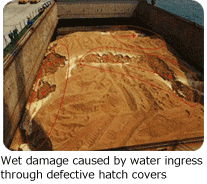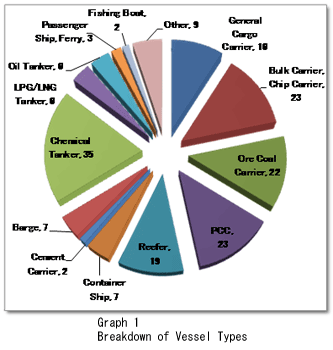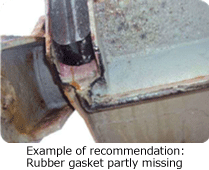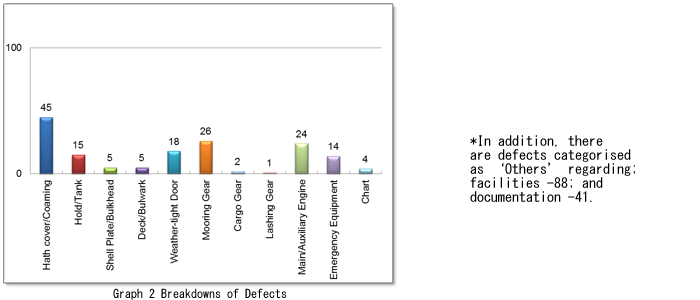P&I Condition Surveys for Loss Prevention
With the continuing trend of occurrence of large claims, there has been growing international action to remove sub-standard vessels from the world’s seas. Loss prevention is a key element of achieving this goal. As part of our loss prevention activities, we conduct Condition Surveys for both new-entry and vessels already entered with the Association.
In this article, we discuss the following points:
- Implementation Status of Condition Surveys
- New Condition Survey Forms
- Changes to the Survey Criteria
1. Implementation Status of Condition Surveys
The scope of Condition Surveys is not always limited to check the overall general condition of a vessel. In addition, the Surveys look at other aspects, such as shipboard maintenance, management status, licenses and career as officers at sea, safekeeping of relevant certificates, documents and record books. The Surveys aim to take into account every possible accident which may occur. Thus, there are very various points to be checked.
In addition to the above check points, the weather-tightness tests as described below are usually carried out. The purpose of these tests is to ensure the weather-tightness of openings such as covers and lids to vessels’ cargo holds and tanks. The tests are not limited to a visual inspection. By conducting the weather-tightness tests, any defects in the covers and lids should be detected and possible risks of wet and / or contamination damage to cargoes by sea water ingress to cargo holds and tanks through the defects and / or openings should be prevented. In addition, by actually opening and closing hatch covers during the survey, it can be ascertained whether the opening and closing systems of the hatches work well without delay. It can thus be assumed whether the vessel personnel’s response can be properly made if sudden precipitation occurs during cargo operations.
Whilst there are various types of vessels with openings to cargo holds or cargo tanks, in this article we would like to focus on dry cargo carriers and their hatch covers’ weather-tightness.
 Ensuring the weather-tightness of hatch covers
Ensuring the weather-tightness of hatch covers
Reviewing cases of cargo damage involving dry cargo carriers, a number of incidents of wet damage caused by water ingress whilst sailing in rough weather can be found. In most cases it is later identified that the hatch covers were in poor condition. Daily maintenance of and appropriate repairs to hatch cover components including rubber gaskets, compression bars, drain channels, non-return valves and cleats may cost time and money. However, if these had been done appropriately, most wet damage cases could have been avoided.
To ensure the weather-tightness of hatch covers is, needless to say, very closely tied to the issue of reducing the number of claims, and it should be of great interest to all of our members.
Ultrasonic testing of hatch covers
In order to check the weather-tightness of hatch covers of dry cargo carriers, two kinds of tests have been conventionally applied. One is the hose test under which water is jetted on to hatch covers and the other is the chalk test under which after compression bars are chalked, hatch covers are closed and then opened in order to ascertain whether chalk sticks to rubber gaskets. However, the ultrasonic test has become the international standard in recent years, and we have adopted this as the standard method in our Condition Surveys.The merits and demerits of each method are as follows:
|
Hose test - Testing is allowed only under limited circumstances since it needs to use water.
(eg. it is not allowed if the vessel is at private berths or there are cargoes on deck.) - Cargo holds need to be empty. - It requires the vessel’s G.S. pumps and fire hoses to be used for the test. - Results may vary because there are different angles, pressure, distance and walking speeds with every handler while water is being jetted. - It may not be possible to ascertain the weather-tightness of hatch covers if there are any recesses which jetting water does not reach appropriately. - Testing is not available if the temperature is below freezing. Chalk test - As chalk easily sticks to rubber gaskets if there is even slight contact between the compression bars and the rubber, the hatch covers may not be sufficiently weather-tight to be cargo-worthy if the rubber gaskets become aged and hardened.
- Chalking the compression bars takes a long time and is labour-intensive. - Testing is allowed only in fine weather. Ultrasonic test - Weather-tightness of all hatch covers can be tested evenly.
- It saves a lot of time and trouble in comparison with the other methods set out above. - Testing can be done even the temperature is below freezing. - So long as the transmitter can be placed inside the vessel’s holds, test results can be obtained even when there is cargo on board. |
To conduct an ultrasonic test, the transmitter is placed inside a cargo hold and the ultrasonic signal level is measured by the receiver while the hatch covers are kept open. Then, the hatch covers are closed and the ultrasonic signal level surrounding the hatch coamings and joint areas is measured. If the leak level detected is below 10% of the open hatch signal level, the hatch covers can be considered as “leak tight”, and thus to be approved as weather-tight.

181 vessels were surveyed during the 2012 Policy yearDuring the 2012 Policy year (from 20th February 2012 until 20th February 2013), 181 vessels were surveyed in total (145 being entered vessels and 36 pre-entry).

Please see Graph 1 for the types of vessels surveyed. Surveys are conducted not only in Japan at ports and dockyards abroad.
| 66% of all Condition Surveys resulted in recommendations for rectification |
Out of 181 vessels, 61 vessels were found in good condition and 120 vessels, or roughly 66% of all Condition Surveys, resulted in recommendations from us for defects to be rectified.
 Most of the vessels received more than one recommendation and the total number of defects found during 2012 Policy year was 291. To see a breakdown of the defects, please refer to Graph 2. The area where defects were found most frequently was Hatch Covers/Coamings, followed by Mooring Gears including defects in windlasses, mooring winches and hawsers. During the 2012 Policy year, Defects Warranties were attached to 8 vessels, and we have notified the Members concerned of the resulting restriction in cover.
Most of the vessels received more than one recommendation and the total number of defects found during 2012 Policy year was 291. To see a breakdown of the defects, please refer to Graph 2. The area where defects were found most frequently was Hatch Covers/Coamings, followed by Mooring Gears including defects in windlasses, mooring winches and hawsers. During the 2012 Policy year, Defects Warranties were attached to 8 vessels, and we have notified the Members concerned of the resulting restriction in cover.

Loss Prevention
In order to ensure the seaworthiness and cargo-worthiness of a vessel, keeping to a daily maintenance programme and management of all equipment and facilities are crucial. Preventing any problems arising with the crew’s safety and health, regular cleaning and taking safety measures are also of great importance.Apart from the wet damage claims explained above, many other claims were triggered by a lack of maintenance. To tackle those, we will continue enhancing Condition Surveys for both new-entry and vessels already entered with the Association in the 2013 Policy year.
2. New Condition Survey Forms
Condition Survey report forms are developed jointly with the International Group of P&I Clubs. For the 2013 Policy year, we have adopted the new survey form, Ver. 6.0.
The new form includes a revision of some check-items in accordance with the specific characteristics of each vessel type. It also incorporates new check-items corresponding to relevant conventions such as SOx regulations and the Ballast Water Convention, as well as the mandatory carriage requirements of nautical equipment including ECDIS (Electronic Chart Display and Information System), BNWAS (Bridge Navigational Watch Alarm System), VDR (Voyage Data Recorder) and ETA (Emergency Towing Arrangements).
The cause of most serious accidents can be attributed to ‘Human Error’. This highlights the current state of crew being appointed at higher rank without sufficient education and experience at sea. For this reason, new check-items have been added to verify the crew’s nationality, licenses and experience.
In addition, to the form asks whether the Association’s Loss Prevention publications are kept onboard and used for safe working (Part B Item 4.4.11). All P&I Clubs in the International Group place great importance on loss prevention in order to tackle the upward trend in the number of claims and their increased cost. Part of this effort is publishing loss prevention bulletins to be sent to entered vessels. This item allows us to see if these publications have been sent to vessels and are being made use of effectively.
The Association’s loss prevention publications include the Master’s Handbook, Loss Prevention Bulletins, Japan P&I News and Japan P& I Newsletters (which occasionally include loss prevention-related articles). We do not require all the publications to be kept on board since some of them concern only specific types of vessels, but please make sure that the vessels receive necessary publications and keep them onboard.
The new survey forms Ver.6.0 are available on our website:
| Condition Survey Forms Ver. 6.0 https://www.piclub.or.jp/eng_lossprevention/conditionsurvey/?lang=english |
3. Changes to the Survey Criteria
Condition survey criteria have been partly revised since 1st May 2013.Having reviewed the tendency of occurrence of claims in the past, we have set target ages for ships to be surveyed one year younger (with some exceptions), to pick the best possible time for condition surveys, such as the time entering dockyards. The purpose of this change is to make survey arrangements more smooth and timely (and surveys do not necessarily have to be carried out at dockyards). Further, we have dropped the criterion of whether the vessel is insured against Indemnity risks. Condition Surveys should focus not only on seaworthiness and cargo-worthiness but also the safety management status like ISM as important check-items. The time for re-inspection is put off for one year as described in 4) below.
Main changes are as below:
1) Targeted age
|
Pre-entry surveys |
|||
|
Chemical Tankers etc.: |
6 years old and over |
⇒ |
5 years old and over |
|
Entered vessels |
|||
|
Chemical Tankers etc.: |
6 years old and over |
⇒ |
5 years old and over |
|
Reefer: |
11 years old and over |
⇒ |
10 years old and over |
|
Others: |
16 years old and over |
⇒ |
15 years old and over |
It is evident from claims records that younger vessels do not necessarily experience fewer accidents than older vessels. To take an example, out of cargo claims suffered by Chemical Tankers etc., more than US$50,000 in the last 5 years, 63% of the claims have arisen on vessels aged 6 years or younger.
2) Targeted vessel types
Chemical Tankers etc.: Chemical Tanker with coated tanks, Methanol Tanker, Product Tanker,
Sulphuric Acid Tanker, Molasses Tanker, Clean Tanker,
Ore/Chemical Carrier
Reefer: Reefer, Cold-storage/Oil carrier
3) Indemnity Risks
4) Re-inspection
Taking into account the changes of the targeted age as stated above 1), the period for re-inspection has been changed from 4 years to 5 years. However, the time for re-inspection is to be set individually for vessels having caused two or more similar accidents arising out of un-seaworthiness, or those having undergone Condition Surveys, in order to resolve doubts as to the occurrence of damage.
The new survey criteria are as follows.
Our Members’ kind understanding and cooperation would be highly appreciated.
|
Survey Criteria: (1) Pre-entry surveys: All vessels - 10 years old and over, however also;
Any chemical tankers etc.*1 - 5 years old and over (*1) chemical tanker with coated tanks, methanol tanker, product tanker, sulphuric acid tanker, molasses tanker, clean tanker, ore/chemical carrier (2) Entered vessels: All vessels - at 15 years old, however also;
(a) Any vessels suffering two or more similar accidents due to un-seaworthiness
(b) Any chemical tankers etc.*1 - at 5 years old (c) Any reefer vessels *2– at 10 years old (d) Any tankers which have carried Heavy Fuel Oil (HFO) as cargo within the last 12 months - 10 years old and over; unless; the vessel has undergone our Condition Survey within the last 12 months; or the vessel has undergone a special survey by a Classification Society within the last 6 months; or the vessel has a current CAP 1 or CAP 2 rating issued by an IACS classification society. (*2) reefer, cold-storage/oil carrier
(3) Re-inspection
(a) All vessels surveyed under (1) and (2): Every 5 years
(b) Vessels entered at 20 years old and over: Every 2 years Note:-
|




